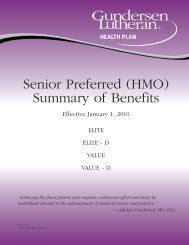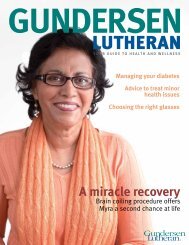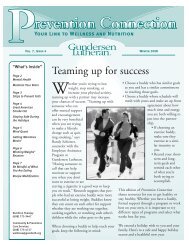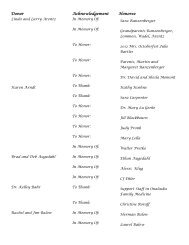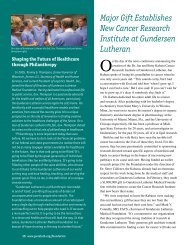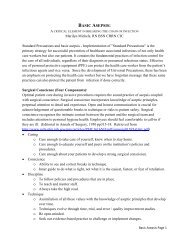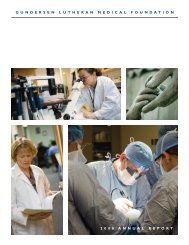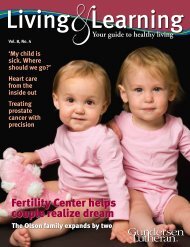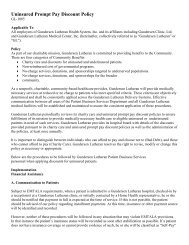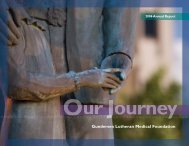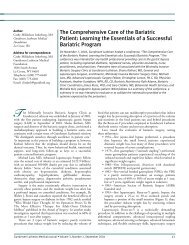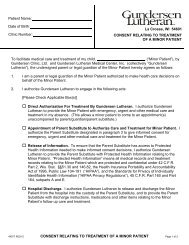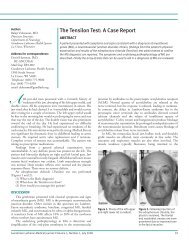ndersen er an - Gundersen Health System
ndersen er an - Gundersen Health System
ndersen er an - Gundersen Health System
Create successful ePaper yourself
Turn your PDF publications into a flip-book with our unique Google optimized e-Paper software.
Authors:<br />
Jeffrey S. Sartin, MD<br />
Section of Infectious Disease<br />
Department of Int<strong>er</strong>nal Medicine<br />
Gu<strong>nd<strong>er</strong>sen</strong> Luth<strong>er</strong><strong>an</strong> <strong>Health</strong> <strong>System</strong><br />
La Crosse, Wisconsin<br />
Douglas L<strong>an</strong>ska, MD, MS, MSPH,<br />
FAAN<br />
Vet<strong>er</strong><strong>an</strong>s Affairs Medical Cent<strong>er</strong><br />
Great Lakes <strong>Health</strong>care <strong>System</strong><br />
Tomah, Wisconsin<br />
Professor of Neurology<br />
Univ<strong>er</strong>sity of Wisconsin School of<br />
Medicine <strong>an</strong>d Public <strong>Health</strong><br />
Madison, Wisconsin<br />
Surgeon Gen<strong>er</strong>al William A. Hammond<br />
(1828-1900):<br />
Successes <strong>an</strong>d Failures of Medical Lead<strong>er</strong>ship<br />
Abstract<br />
A controv<strong>er</strong>sial charact<strong>er</strong> in his day, William A. Hammond made a numb<strong>er</strong> of lasting<br />
contributions to the medical profession in the second half of the 19th century. H<strong>er</strong>e we<br />
recount the highlights <strong>an</strong>d the lowlights of Hammond’s long <strong>an</strong>d lively care<strong>er</strong>.<br />
Address for correspondence:<br />
Jeffrey S. Sartin, MD<br />
Mail Stop C02-007<br />
Gu<strong>nd<strong>er</strong>sen</strong> Luth<strong>er</strong><strong>an</strong> <strong>Health</strong> <strong>System</strong><br />
1900 South Avenue<br />
La Crosse, WI 54601<br />
Telephone: (608) 782-7300<br />
Fax: (608) 775-5542<br />
email: jssartin@gundluth.org<br />
Having rushed up the stairs of his Washington home<br />
with charact<strong>er</strong>istic alacrity, on J<strong>an</strong>uary 5, 1900,<br />
William Alex<strong>an</strong>d<strong>er</strong> Hammond, MD, collapsed with <strong>an</strong> acute<br />
coronary occlusion that would soon prove fatal. Thus ended the<br />
life of a remarkable physici<strong>an</strong> <strong>an</strong>d m<strong>an</strong> of science, whose long<br />
care<strong>er</strong> sp<strong>an</strong>ned the tr<strong>an</strong>sition of medicine from a relatively crude<br />
<strong>an</strong>d ineffective empiricism to a profession based on scientific<br />
principles. He is best rememb<strong>er</strong>ed today as the unfortunate victim<br />
of Washington politics, being the only Army Surgeon Gen<strong>er</strong>al to<br />
suff<strong>er</strong> the indignity of a court-martial <strong>an</strong>d removal from office in<br />
1863. Nev<strong>er</strong>theless, he had <strong>an</strong> illustrious care<strong>er</strong> as a seminal figure in<br />
Am<strong>er</strong>ic<strong>an</strong> neurology, <strong>an</strong>d his innovative org<strong>an</strong>izational lead<strong>er</strong>ship<br />
produced new military <strong>an</strong>d civili<strong>an</strong> specialty hospitals, signific<strong>an</strong>t<br />
improvements in military medical care, a ground-breaking history<br />
of medical care during the Civil War, <strong>an</strong>d various oth<strong>er</strong> institutions<br />
<strong>an</strong>d professional medical org<strong>an</strong>izations.<br />
Hammond’s lead<strong>er</strong>ship successes w<strong>er</strong>e bal<strong>an</strong>ced by signific<strong>an</strong>t<br />
failures, <strong>an</strong>d more th<strong>an</strong> a century aft<strong>er</strong> his death his legacy remains<br />
complicated <strong>an</strong>d controv<strong>er</strong>sial. Hammond was indeed a colorful<br />
<strong>an</strong>d complex charact<strong>er</strong> with both consid<strong>er</strong>able attributes <strong>an</strong>d<br />
faults: a brilli<strong>an</strong>t org<strong>an</strong>iz<strong>er</strong> <strong>an</strong>d administrator, <strong>an</strong>d <strong>an</strong> outst<strong>an</strong>ding<br />
teach<strong>er</strong> <strong>an</strong>d apostle of neurology, but at best a mediocre if prolific<br />
scholar. More problematically, he came across as <strong>an</strong> audacious,<br />
contentious, boastful, <strong>an</strong>d arrog<strong>an</strong>t individual 1 with “a voice so<br />
pow<strong>er</strong>ful that it could be heard up-wind in a hurric<strong>an</strong>e.” 2 In his<br />
appetites <strong>an</strong>d endeavors Hammond symbolized the best <strong>an</strong>d worst<br />
of Am<strong>er</strong>ic<strong>an</strong> culture as it barreled through the latt<strong>er</strong> half of the<br />
19th century.<br />
Early Care<strong>er</strong><br />
William Hammond was born on August 28, 1828, in Annapolis,<br />
Maryl<strong>an</strong>d, <strong>an</strong>d grew up in Harrisburg, Pennsylv<strong>an</strong>ia. By the age of<br />
20 he had completed his medical training at the Univ<strong>er</strong>sity of the<br />
City of New York. In July 1848 he married his first wife, Helen<br />
Nisbet, <strong>an</strong>d beg<strong>an</strong> his s<strong>er</strong>vice in the Army in the dist<strong>an</strong>t post of<br />
New Mexico T<strong>er</strong>ritory. His various postings throughout the West<br />
afforded him a steady income for his burgeoning family, soon to<br />
include 3 children, as well as the opportunity to learn medicine<br />
<strong>an</strong>d engage in scientific inquiries in <strong>an</strong> arena far removed from the<br />
constraints of the east<strong>er</strong>n medical establishment. 3<br />
He approached his work with precision <strong>an</strong>d imagination, <strong>an</strong>d<br />
his reputation as a medical offic<strong>er</strong> in the Army <strong>an</strong>d as a scientific<br />
investigator blossomed throughout the 1850s. He had at least 24<br />
publications on various topics — particularly nutrition, physiology,<br />
<strong>an</strong>d toxicology — during that decade. His military s<strong>er</strong>vice was<br />
int<strong>er</strong>rupted for a while in 1852, as he m<strong>an</strong>ifested the first signs<br />
of the peculiar <strong>an</strong>d disabling cardiac condition that would trouble<br />
him int<strong>er</strong>mittently for the next 8 years. In 1857 he won the<br />
Am<strong>er</strong>ic<strong>an</strong> Medical Association’s essay prize for his entry on “The<br />
Nutritive Value <strong>an</strong>d Physiological Effects of Albumen, Starch,<br />
<strong>an</strong>d Gum,” based on exp<strong>er</strong>iments <strong>an</strong>d obs<strong>er</strong>vations with himself<br />
as the test subject. 4 Toward the end of his early Army care<strong>er</strong> in<br />
1858 he spent <strong>an</strong> extended medical leave in Philadelphia, wh<strong>er</strong>e<br />
he collaborated with oth<strong>er</strong> young physici<strong>an</strong>s, including Silas Weir<br />
Mitchell (1829-1914), in establishing <strong>an</strong> elite research society,<br />
the Philadelphia Biological Society. His association with Mitchell<br />
would lat<strong>er</strong> bear fruit in the adv<strong>an</strong>cement of the field of neurology<br />
Gu<strong>nd<strong>er</strong>sen</strong> Luth<strong>er</strong><strong>an</strong> Medical Journal • Volume 5, Numb<strong>er</strong> 1, July 2008 21




